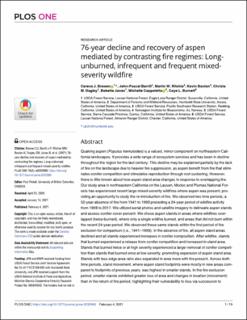| dc.description.abstract | Quaking aspen (Populus tremuloides) is a valued, minor component on northeastern California landscapes. It provides a wide range of ecosystem services and has been in decline throughout the region for the last century. This decline may be explained partially by the lack of fire on the landscape due to heavier fire suppression, as aspen benefit from fire that eliminates conifer competition and stimulates reproduction through root suckering. However, there is little known about how aspen stand area changes in response to overlapping fire. Our study area in northeastern California on the Lassen, Modoc and Plumas National Forests has experienced recent large mixed-severity wildfires where aspen was present, providing an opportunity to study the re-introduction of fire. We observed two time periods; a 52-year absence of fire from 1941 to 1993 preceding a 24-year period of wildfire activity from 1993 to 2017. We utilized aerial photos and satellite imagery to delineate aspen stands and assess conifer cover percent. We chose aspen stands in areas where wildfires overlapped (twice-burned), where only a single wildfire burned, and areas that did not burn within the recent 24-year period. We observed these same stands within the first period of fire exclusion for comparison (i.e., 1941–1993). In the absence of fire, all aspen stand areas declined and all stands experienced increases in conifer composition. After wildfire, stands that burned experienced a release from conifer competition and increased in stand area. Stands that burned twice or at high severity experienced a larger removal of conifer competition than stands that burned once at low severity, promoting expansion of aspen stand area. Stands with less edge:area ratio also expanded in area more with fire present. Across both time periods, stand movement, where aspen stand footprints were mostly in new areas compared to footprints of previous years, was highest in smaller stands. In the fire exclusion period, smaller stands exhibited greater loss of area and changes in location (movement) than in the return of fire period, highlighting their vulnerability to loss via succession to conifers in the absence of disturbances that provide adequate growing space for aspen over time. | en_US |

